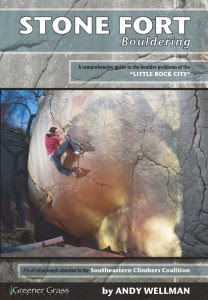
I don't know about you guys, but every time I get a new guidebook I get new motivation and new excitement for bouldering...especially if its a good guidebook! This guidebook is no exception. Its been a couple of years since I've been able to make it to Little Rock City, but for several years while I lived part time in Knoxville, LRC was one of my home crags. Even though I've spent more time at other bouldering areas since then, there is still a little piece of me that considers LRC to be some of my home boulders. The sandstone is impeccable and possibly the best in the Southeast. The boulders are perfect in size and shape with plenty of variety to suit any boulderer. The current access situation is great...only a few bucks a day gets you in to one of the best "outdoor gyms" on the planet. And when you're done with your day, there's nothing like kicking back a beer in the clubhouse to celebrate your sends!

The history of the Stone Fort/Little Rock City/LRC is muddy and pieced together in the guidebook by snap shots of the boulderfield from different climber's perspectives, over different times.
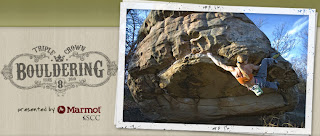
Even the name has some confused...I've always called it Little Rock City or LRC for short, but the developer, when the Triple Crown Bouldering Series approached about using the boulders for the comp, decided he wanted to distinguish the area from the big Chatty attraction Rock City...and the name Stone Fort was born.

Most local boulderers know the area by both different names and you can even tell who-climbed-when by the name they prefer to refer to the area by.
Marvin Webb (Thanks for your Southeast bouldering influence...I'm a fan of the Marvin Webb Slab at Boat Rock!) may have been one of the first real climbers to investigate the area back in the early '80's, and from there the legend began to grow. More and more people found out about the area through different means and eventually it became a popular bouldering crag. Eventually though, its popularity and the constraints of the Montlake golf course shut the place down for many years. The SCC and Triple Crown organizers finally cracked the nut in 2003 and LRC was open to the public on a sustainable management plan. This plan has changed a few times since then, but what hasn't changed is the incredible access and opportunity that any climber has to enjoy this world class destination! The patchwork history is presented in a series of 13 essays, contributed by different authors from different generations of LRC climbing, and is a great read in itself. The first time I read through the book, I actually found myself thumbing past all of the classic problems to get to the next essay, and next chunk of history...very unlike me.

The guidebook itself doesn't disappoint! As I mentioned in my review of the Horse Pens 40 Bouldering Guide, I've travelled to several different world class boulderfields in several different states and countries...and I've seen/used the gamut of guidebooks. Greener Grass's format is one of the easiest to understand and use. Its very simple to compare the topo to the pictures of the routes drawn on the boulders and know exactly where you're at...especially compared to the old Triple Crown guide. I haven't been able to make it to the Triple Crown comp at LRC, but I was fortunate to get a copy of the comp guide...so I have always had to stumble around the boulders, using the comp guide, looking clueless and trying to find a boulder and route that should be right in front of me. Now, finding routes and boulders in the boulderfield is easier than ever!
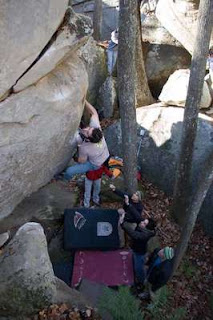
Besides the easy to use format and design that was made popular in the HP40 Bouldering Guide, there are also some incredible photos to glare at too. The same high quality, vivid images take you there and help you soak in the beauty and excellence of this boulderfield. The action shots are incredible and help with a little beta, while the topo photos are clear and easy to use and understand. The problems are color coded on the map to help you find the grade range that best suits your ability. The problem descriptions are concise and help bring many of the routes to life with the occasional history reference or anecdote. The introduction for each area has a small reference picture of the whole boulderfield, along with a close up overview of that specific area, which points out all of the boulders in that area. A brief description, ticklist of the classics, and grade distribution chart are also included in each intro to help you get a feel for the area and zero in on what's best for you to send. As you thumb through to each boulder in each area, more detailed topo's of each boulder are presented to get you to the right route...and the photo topo's make it fool proof to find what you're looking for. This may be the best thing about this guidebook...in the past, the travelling boulderer just wandered around aimlessly, relying on the kindness of a local to point out where the "good stuff" was. Now the secrets to each area have been unlocked and presented in an easy to understand format. If you haven't clicked over to Greener Grass's website and checked out the sample pages for this guide, go over there now and see the details, incredible topo's and photos I'm talking about. I'm so glad that this perfect boulderfield finally got the perfect presentation it deserves!

This book was a winner and the 2 Southern Bouldering books combined, set the new standard for what all bouldering guidebooks should live up to. Andy Wellman's calm and cool demeanor was apparent while reading the book, making it more enjoyable to read. His friendly attitude may upset locals that feel he's moved in on their turf and demystified this once hush-hush crag. I'm personally glad to see this style of information becoming more popular and more areas are being recorded and made available to everybody. I've been to plenty of places that locals covet their boulders to the point that they have actually ruined it for much of the rest of the bouldering community (sometimes Boone has this "locals only" attitude to a fault), and I'm glad to see the South slowly loosen its prudence belt and embrace others/outsiders enjoying its areas. I mean it cant be world class if the rest of the world cant enjoy it too!
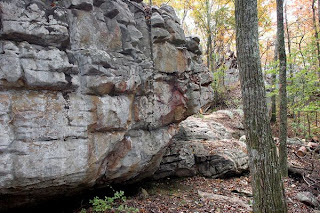
Jimmy Webb's closing essay echoes my exact sentiments about LRC...respect and gratitude for those that have come before me, and excitement and anticipation for the excellent resource future generations of climbers will be able to enjoy. Thanks to the SCC and the Tripe Crown for working so hard with Montlake and the entire community and getting this place open on a sustainable management plan! Click here for more information on LRC access and a great photo gallery of this amazing boulderfield. Don't forget that 5% of the proceeds from this book will be given back to the SCC to help out with their ongoing diligence in saving our southern crags!
The book is available for preorder at a discounted rate...I advise picking one up on this sale and you'll receive it the same day as the stores do. You'll have a slight jump on the rest of the crowd that is sure to ensue:)
Next weekend I'll be taking the guidebook for a 3 day test drive, and I plan on posting an update to this review as soon as I get back. I always like to use the guide in the field before I give my absolute final opinion...so stay tuned!

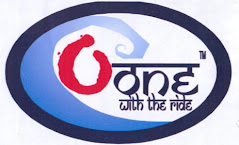







No comments:
Post a Comment